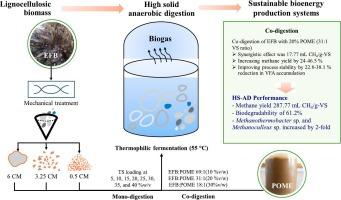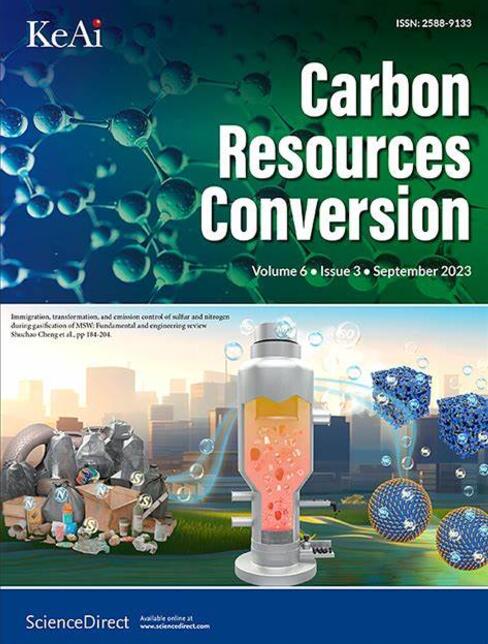在嗜热条件下,通过减小粒径和与棕榈油厂污水共同消化,提高空果串的高固态厌氧消化效率
IF 7.5
3区 环境科学与生态学
Q2 ENERGY & FUELS
引用次数: 0
摘要
本研究调查了嗜热高固相厌氧消化(HS-AD)对空果束(EFB)沼气生产的影响,重点研究了总固体(TS)负荷(5 - 40%)、颗粒尺寸减小(0.5、3.25和6 cm)以及与棕榈油厂废水(POME)共消化(10 - 30% VS基础)的影响。在15 - 20% TS负荷下,HS-AD的甲烷产率为103.4-105.3 mL CH4/g-VS,生物降解率为24.6 - 25.1%。在15 - 20%的TS负载下,与未处理的EFB (6 cm)相比,将粒径减小至0.5 cm可使甲烷产率提高54 - 61%,水解率提高45%。在VS基础上,EFB与POME以31:1的比例共消化,产生了17.77 mL CH4/g-VS的协同效应,甲烷产量提高了24 - 46.5%,挥发性脂肪酸(VFAs)积累减少了22.8 - 38.1%,提高了工艺稳定性。微生物群落分析表明,在共消化过程中,氢营养产甲烷菌(Methanothermobacter sp.和Methanoculleus sp.)的相对丰度增加了2倍,而关键的纤维素分解细菌(Clostridium sp.和Fibrobacter sp.)的相对丰度增加了1.5倍。优化后的HS-AD工艺在POME共消化添加量为20% (VS比为31:1)、粒径为0.5 cm的条件下,甲烷产率最高为287.77 mL CH4/g-VS,生物降解率为61.2%。这些发现证明了嗜热HS-AD对EFB可持续管理的潜力,并强调了工艺优化和共消化策略对提高EFB沼气产量的重要性。本文章由计算机程序翻译,如有差异,请以英文原文为准。

Enhancing the efficiency of high solid anaerobic digestion of empty fruit bunches under thermophilic conditions by particle size reduction and co-digestion with palm oil mill effluent
This study investigates the impact of thermophilic high solid anaerobic digestion (HS-AD) on biogas production from empty fruit bunches (EFB), focusing on the effects of total solids (TS) loading (5–40 %), particle size reduction (0.5, 3.25, and 6 cm), and co-digestion with palm oil mill effluent (POME) (10–30 % VS basis). The HS-AD at a 15–20 % TS loading has a methane yield of 103.4–105.3 mL CH4/g-VS with 24.6–25.1 % biodegradability. Particle size reduction to 0.5 cm enhanced methane yield by 54–61 % and improved hydrolysis rates by 45 % compared to the untreated EFB (6 cm) at a 15–20 % TS loading. Co-digestion of EFB with POME at a ratio of 31:1 based on VS basis led to a synergistic effect of 17.77 mL CH4/g-VS, increasing methane yield by 24–46.5 % and improving process stability, as evidenced by a 22.8–38.1 % reduction in volatile fatty acids (VFAs) accumulation. Microbial community analysis showed a 2-fold increase in the relative abundance of hydrogenotrophic methanogens (Methanothermobacter sp. and Methanoculleus sp.) during co-digestion, while the abundance of key cellulolytic bacteria (Clostridium sp. and Fibrobacter sp.) increased by 1.5-fold. The optimized HS-AD process achieved a maximum methane yield of 287.77 mL CH4/g-VS and a biodegradability of 61.2 % under thermophilic conditions, with a 20 % POME co-digestion addition (31:1 VS ratio) and 0.5 cm particle size. These findings demonstrate the potential of thermophilic HS-AD for the sustainable management of EFB and highlight the importance of process optimization and co-digestion strategies for enhanced biogas production from EFB.
求助全文
通过发布文献求助,成功后即可免费获取论文全文。
去求助
来源期刊

Carbon Resources Conversion
Materials Science-Materials Science (miscellaneous)
CiteScore
9.90
自引率
11.70%
发文量
36
审稿时长
10 weeks
期刊介绍:
Carbon Resources Conversion (CRC) publishes fundamental studies and industrial developments regarding relevant technologies aiming for the clean, efficient, value-added, and low-carbon utilization of carbon-containing resources as fuel for energy and as feedstock for materials or chemicals from, for example, fossil fuels, biomass, syngas, CO2, hydrocarbons, and organic wastes via physical, thermal, chemical, biological, and other technical methods. CRC also publishes scientific and engineering studies on resource characterization and pretreatment, carbon material innovation and production, clean technologies related to carbon resource conversion and utilization, and various process-supporting technologies, including on-line or off-line measurement and monitoring, modeling, simulations focused on safe and efficient process operation and control, and process and equipment optimization.
 求助内容:
求助内容: 应助结果提醒方式:
应助结果提醒方式:


